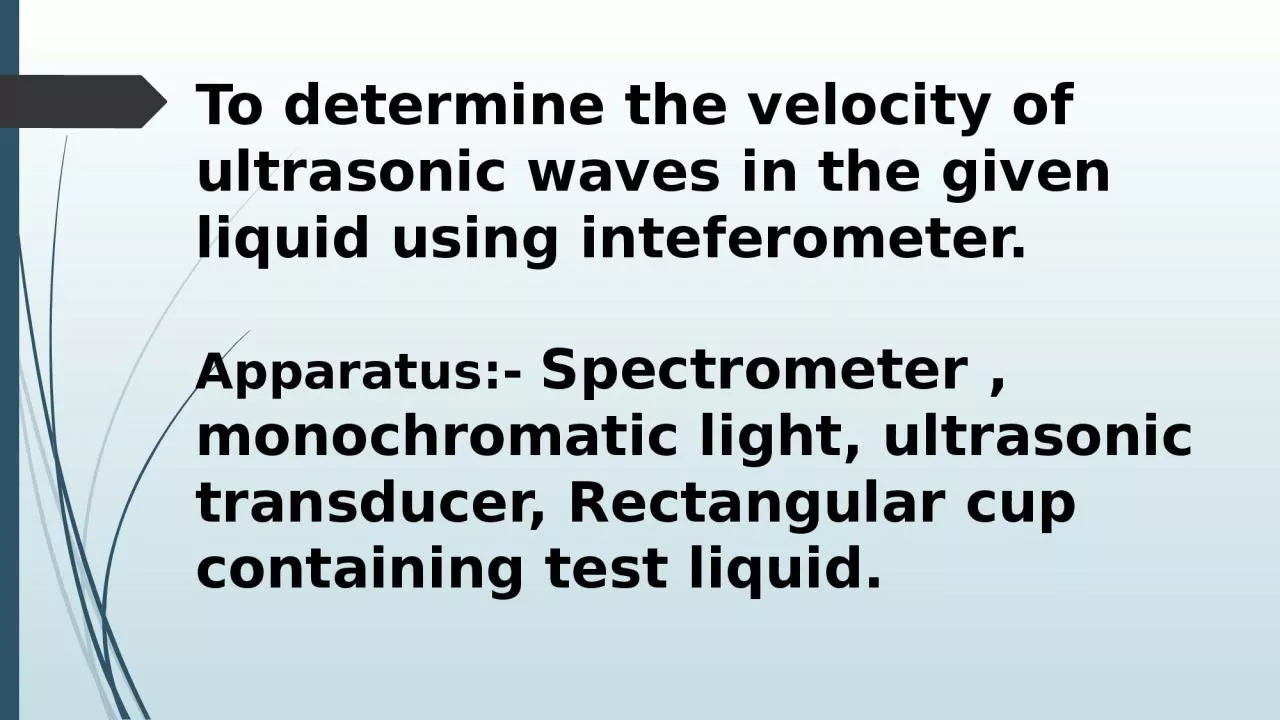

inteferometer Apparatus Spectrometer monochromatic light ultrasonic transducer Rectangular cup containing test liquid Theory Ultrasonic interferometer is a simple device which yields accurate and consistent data from which one can determine the velocity of u ID: 1001413
Download Presentation The PPT/PDF document ". To determine the velocity of ultrason..." is the property of its rightful owner. Permission is granted to download and print the materials on this web site for personal, non-commercial use only, and to display it on your personal computer provided you do not modify the materials and that you retain all copyright notices contained in the materials. By downloading content from our website, you accept the terms of this agreement.
1. .To determine the velocity of ultrasonic waves in the given liquid using inteferometer. Apparatus:- Spectrometer , monochromatic light, ultrasonic transducer, Rectangular cup containing test liquid.
2. .
3. .
4. . Theory:- Ultrasonic interferometer is a simple device which yields accurate and consistent data, from which one can determine the velocity of ultrasonic sound in a liquid medium. Ultrasonics:
5. .Ultrasonic sound refers to sound pressure with a frequency greater than the human audible range (20HZ to 20 KHz). When an ultrasonic wave propagates through a medium, the molecules in that medium vibrate over very short distance in a direction parallel to the longitudinal wave.During this vibration, momentum is transferred among molecules. This causes the wave to pass through the medium.FormulaUsed:-
6. . Principle:- When ultrasonic waves travel through a transparent liquid, due to alternate compression and rarefaction, longitudinal stationary waves are produced.tothese waves,If monochromatic light is passed through the liquid perpendicular the liquidbehaves as diffraction grating.Such a grating is known as Acoustic Grating. Here the lines of compression and rarefaction act as transparent light waves. It is used to find wavelength and velocity(v) of ultrasonic waves in the liquid. Using the value of 1, the velocity (v) can be obtained by the relation v= 1×fConstruction:- It is of a glass tank, filled with the liquid. A piezoelectric (Quartz) is fixed at the bottom of the glass tank and is connected with piezo-electric oscillatory circuit as shown in the figure:
7. .An incandescent lamp is used as a monochromatic source (S) and a telescope arrangement is used to view the diffraction pattern. A collimator consisting of two lenses L1 and L2 is used to ocus the light effectively in the glass tank.
8. .Working:- I) When the piezo-electric crystal is kept at rest:Initially the piezoelectric crystal is kept at rest and themonochromaticatislight switched ON. When the light is focused in the glass tank filled with the liquid, a single image, a vertical peak is observed in telescope. i.e., there is no diffraction.
9. .(ii) When the piezoelectric crystal is set into vibrations:Now the crystal is put into vibration using piezo-electric oscillatory circuit. At Resonance, Ultrasonic waves are produced and are passed through the liquid. These Ultrasonic waves are reflected by the walls of the glass tank and form a stationery wave pattern with nodes and antinodes in the liquid. At nodes the density of the liquid becomes less. Thus, the liquid behaves as a directing element called acoustical grating element. Now when the monochromatic light is passed the light gets directed and a diffraction pattern consisting of central maxima and principle maxima on either side is viewed through the telescope as shown figure
10. .Calculation of ultrasonic velocityThe velocity of ultrasonic waves Can be determined Using the condition.
11. .
12. .Thus, this method is useful in measuring the wavelength and velocity of ultrasonic waves in liquids and gases at various temperatures.
13. . Procedure :- Insert the quartz crystal in the socket at the base and clamp it tightly with the help of a screw provided on one side of the instrument.Unscrew the knurled cap of the cell and lift it away. Fill the middle portion with the experimental liquid and screw the knurled cap tightly.Then connect the high frequency generator with the cell.There are two knobs on the instrument- "Adj" and"Gain". With "Adj”, position of the needle on the ammeter is adjusted. The knob "Gain" is used to increase the sensitivity of the instrument. Increase the micrometer setting till the anode current in the ammeter shows a maximum.
14. .Observation table :-
15. .
16. .Precautions :-Do not switch on the generator without filling the experimental liquid in the cell. Remove experimental liquid out of cell after use. Keep it cleaned and dried.Keep micrometer open at 25mm after use.Generator should be given a time of 15 minutes for warming up before the observation (interferometer). The experimental liquid should be taken out of cell after use and the cell should be kept clean and dry.